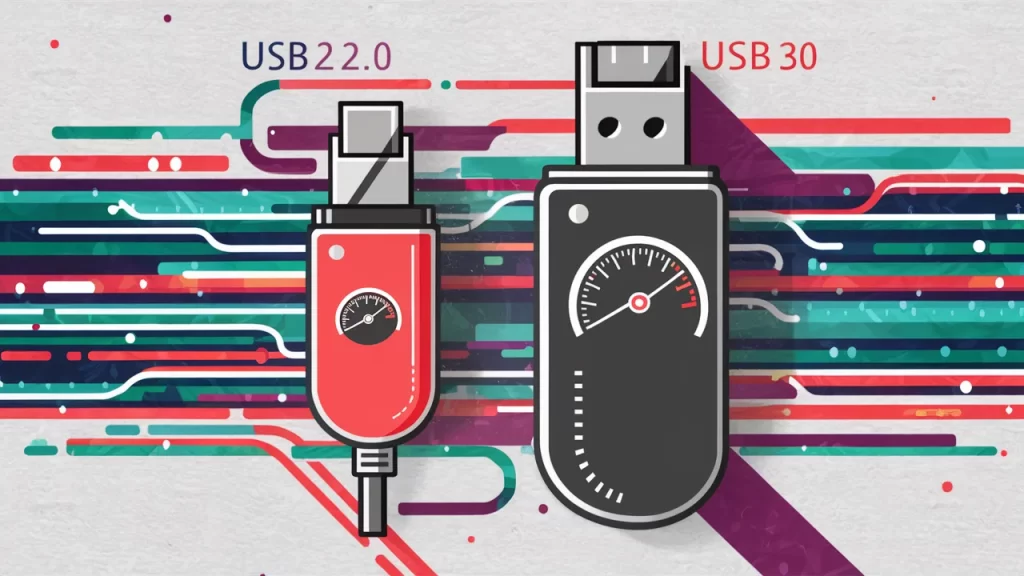If you’re in the market for a new pen drive, you might be wondering: Should you choose USB 2.0 vs USB 3.0 Pen Drives? Let’s make it simple! USB pen drives are a great way to store and share data, but choosing between USB 2.0 and USB 3.0 can be confusing if you’re not familiar with the differences. In this guide, I’ll break down the key points so you can decide which one best suits your needs.
Table of Contents
USB 2.0 vs USB 3.0 Pen Drives: What Are They?
First, let’s quickly explain what these terms mean. USB 2.0 and USB 3.0 refer to different versions of the Universal Serial Bus (USB) standard, which affects how fast the pen drive can read, write, and transfer data.
- USB 2.0 was introduced back in 2000 and has a data transfer rate of up to 480 Mbps (Megabits per second).
- USB 3.0, introduced in 2008, offers up to 5 Gbps (Gigabits per second), which is over ten times faster than USB 2.0!
Key Differences Between USB 2.0 and USB 3.0

1. Speed
The most obvious difference between USB 2.0 and USB 3.0 is speed. If you frequently transfer large files like HD videos or want to back up your data quickly, USB 3.0 is the better choice by a mile. It has a theoretical speed that’s over ten times faster than USB 2.0, making it ideal for people who need to move a lot of data.
2. Compatibility
Both USB 2.0 and USB 3.0 are backward-compatible, meaning you can plug a USB 3.0 pen drive into a USB 2.0 port and vice versa. However, keep in mind that if you plug a USB 3.0 drive into a USB 2.0 port, it will only operate at USB 2.0 speeds. If your computer has a USB 3.0 port, definitely take advantage of it to get those faster speeds!
3. Power Consumption
Another major difference is power efficiency. USB 3.0 devices are generally more power-efficient, which can be an important factor if you’re using them with a laptop or other battery-powered device. They also provide more power to connected devices, which can make a difference when using high-power peripherals.
4. Connector Design
You can tell a USB 3.0 connector apart by its blue color inside the port. This visual cue makes it easy to differentiate from a USB 2.0 port, which is usually black. The connectors in USB 3.0 also have additional pins that allow for higher speed and better power efficiency.
Which One Should You Choose?
The choice between USB 2.0 vs USB 3.0 Pen Drives depends entirely on how you plan to use your pen drive.
- Choose USB 2.0 if: You only need a pen drive for basic tasks like transferring documents, storing small files, or using it with older devices. USB 2.0 drives are usually more affordable, so they are great if you don’t need fast transfer speeds.
- Choose USB 3.0 if: You often work with large files, like videos, photos, or software backups. If you want to save time and take advantage of your computer’s modern ports, go for USB 3.0. It’s a bit more expensive than USB 2.0, but well worth it for the increased speed and performance.
Pros and Cons at a Glance
USB 2.0 Pen Drives
- Pros: More affordable, works well for basic use, compatible with older ports.
- Cons: Slower transfer speeds, not ideal for large files or frequent use.
USB 3.0 Pen Drives
- Pros: Much faster, more efficient power usage, great for large files and frequent use.
- Cons: Usually a bit more expensive.
The Final Verdict for this
If your budget allows it and you need a pen drive for more than just casual use, I strongly recommend going for a USB 3.0 pen drive. The difference in speed and efficiency is significant, and it’s well worth the slightly higher cost. However, if you’re just looking for a simple, affordable solution for storing documents, a USB 2.0 pen drive will do the job just fine.
No matter which one you choose, make sure you shop at a reliable source like EshopCity.in, where you can find both USB 2.0 vs USB 3.0 pen drives with great deals and warranties. You can also check out our detailed guide on Best High-Capacity Pen Drives of 2024 to learn more about different options available for your storage needs.
Ready to make your choice? Head over to EshopCity.in now to find the perfect pen drive that fits your needs and budget! If you’re still unsure, check out our comparison guide on High-Capacity Pen Drives vs Standard Pen Drives for more insights.
